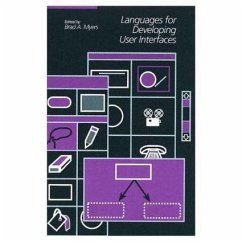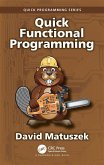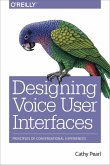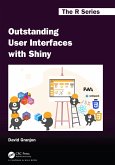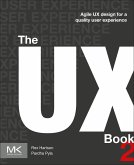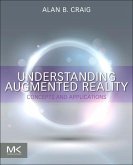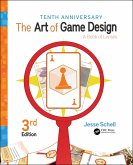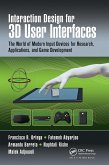Schade – dieser Artikel ist leider ausverkauft. Sobald wir wissen, ob und wann der Artikel wieder verfügbar ist, informieren wir Sie an dieser Stelle.
- Gebundenes Buch
- Merkliste
- Auf die Merkliste
- Bewerten Bewerten
- Teilen
- Produkt teilen
- Produkterinnerung
- Produkterinnerung
This book brings together a number of researchers and developers from industry and academia who report on their work. It is of interest to language designers and the creators of toolkits, UIMSs, and other user interface tools.
Andere Kunden interessierten sich auch für
![Quick Functional Programming Quick Functional Programming]() David MatuszekQuick Functional Programming25,99 €
David MatuszekQuick Functional Programming25,99 €![Designing Voice User Interfaces Designing Voice User Interfaces]() Cathy PearlDesigning Voice User Interfaces34,99 €
Cathy PearlDesigning Voice User Interfaces34,99 €![Outstanding User Interfaces with Shiny Outstanding User Interfaces with Shiny]() David Granjon (Senior Data Science Expert, Novartis, Switzerland)Outstanding User Interfaces with Shiny84,99 €
David Granjon (Senior Data Science Expert, Novartis, Switzerland)Outstanding User Interfaces with Shiny84,99 €![The UX Book The UX Book]() Rex HartsonThe UX Book71,99 €
Rex HartsonThe UX Book71,99 €![Understanding Augmented Reality Understanding Augmented Reality]() Alan B. CraigUnderstanding Augmented Reality65,99 €
Alan B. CraigUnderstanding Augmented Reality65,99 €![The Art of Game Design The Art of Game Design]() Jesse Schell (Carnegie Mellon University and Pittsbur Schell GamesThe Art of Game Design162,99 €
Jesse Schell (Carnegie Mellon University and Pittsbur Schell GamesThe Art of Game Design162,99 €![Interaction Design for 3D User Interfaces Interaction Design for 3D User Interfaces]() Francisco R. OrtegaInteraction Design for 3D User Interfaces49,99 €
Francisco R. OrtegaInteraction Design for 3D User Interfaces49,99 €-
-
This book brings together a number of researchers and developers from industry and academia who report on their work. It is of interest to language designers and the creators of toolkits, UIMSs, and other user interface tools.
Produktdetails
- Produktdetails
- Verlag: B&T / Peters, Wellesley
- Artikelnr. des Verlages: K00428
- Seitenzahl: 476
- Erscheinungstermin: 11. Februar 1992
- Englisch
- Abmessung: 236mm x 155mm x 30mm
- Gewicht: 832g
- ISBN-13: 9780867204506
- ISBN-10: 0867204508
- Artikelnr.: 24254618
- Herstellerkennzeichnung
- Libri GmbH
- Europaallee 1
- 36244 Bad Hersfeld
- gpsr@libri.de
- Verlag: B&T / Peters, Wellesley
- Artikelnr. des Verlages: K00428
- Seitenzahl: 476
- Erscheinungstermin: 11. Februar 1992
- Englisch
- Abmessung: 236mm x 155mm x 30mm
- Gewicht: 832g
- ISBN-13: 9780867204506
- ISBN-10: 0867204508
- Artikelnr.: 24254618
- Herstellerkennzeichnung
- Libri GmbH
- Europaallee 1
- 36244 Bad Hersfeld
- gpsr@libri.de
Myers\, Brad A.
Introduction Part I: Programming Languages for End Users 1. The User Interface is the Language 2. A Component Architecture for Personal Computer Software 3. Design Support Environments for End Users 4. The Use-Mention Perspective on Programming for the Interface 5. Why the User Interface is Not the Programming Language-and How It Can Be Part II: Programming Languages for Programmers 6. How Programming Languages Might Better Support User Interface Tools 7. Requirements for User Interface Programming Languages 8. Languages for the Construction of Multi-User Multi-Media Synchronous (MUMMS) Applications 9. Ideas from Garnet for Future User Interface Programming Languages 10. Constraint Imperative Programming Languages for Building Interactive Systems 11. An Active-Value-Spreadsheet Model for Interactive Languages 12. Properties of User Interface Systems and the Siri Programming Language 13. A Foundation for User Interface Construction 14. User Interface Programming with Cooperative Processes 15. Constructing User Interfaces with Functions and Temporal Constraints 16. Different Languages for Different Development Activities: Behavioral Representation Techniques for User Interface Design 17. Hints on the Design of User Interface Language Features-Lessons from the Design of Thring Part III: Workshop Reports 18. Report of the "End-User Programming" Working Group 19. Report of the "User/Programmer Distinction" Working Group 20. Report of the "Linguistic Support" Working Group 21. Future Research Issues in Languages for Developing User Interfaces
Introduction Part I: Programming Languages for End Users 1. The User Interface is the Language 2. A Component Architecture for Personal Computer Software 3. Design Support Environments for End Users 4. The Use-Mention Perspective on Programming for the Interface 5. Why the User Interface is Not the Programming Language-and How It Can Be Part II: Programming Languages for Programmers 6. How Programming Languages Might Better Support User Interface Tools 7. Requirements for User Interface Programming Languages 8. Languages for the Construction of Multi-User Multi-Media Synchronous (MUMMS) Applications 9. Ideas from Garnet for Future User Interface Programming Languages 10. Constraint Imperative Programming Languages for Building Interactive Systems 11. An Active-Value-Spreadsheet Model for Interactive Languages 12. Properties of User Interface Systems and the Siri Programming Language 13. A Foundation for User Interface Construction 14. User Interface Programming with Cooperative Processes 15. Constructing User Interfaces with Functions and Temporal Constraints 16. Different Languages for Different Development Activities: Behavioral Representation Techniques for User Interface Design 17. Hints on the Design of User Interface Language Features-Lessons from the Design of Thring Part III: Workshop Reports 18. Report of the "End-User Programming" Working Group 19. Report of the "User/Programmer Distinction" Working Group 20. Report of the "Linguistic Support" Working Group 21. Future Research Issues in Languages for Developing User Interfaces

